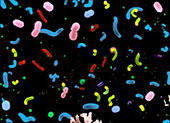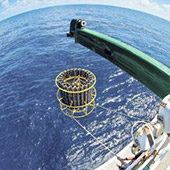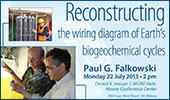- C-MORE Home
- Member Area
- What is Microbial Oceanography?
- What is C-MORE?
- C-MORE Hale
- Partner Institutions
- Sponsors
- External Advisory Committee
- Archived Announcements
- C-MORE Honors
- C-MORE Wikipedia article
- C-MORE Hale
- Research
- Research Cruises
- Data
- Education & Outreach
- People
- Publications
- Microscopy Images
- Professional Development Training Program
- Summer Course
- C-MORE Highlights
- Meeting Facilities
- Contact Us
Archived News and Announcements: 2013–15
Ceremonies at C-MORE Hale celebrating the generous estate gifts of Victor and Peggy Pavel to the University of Hawai‘i, including the establishment of the Victor and Peggy Brandstrom Pavel Endowed Chair in Ocean and Earth Science and Technology at SOEST, of which David M. Karl,, professor of Oceanography and director of C-MORE, is the first recipient.
 The Hawaii Ocean Time-series program has been making repeat measurements at Station ALOHA since 1988. Such time series observations are necessary for helping to build an understanding of how changes in Earth’s climate are influencing marine life. This video was submitted into the Ocean180 Film Challenge, sponsored by the Florida Center for Ocean Sciences Education Excellence. The video is based on work published in the journal Nature Reviews Microbiology.
The Hawaii Ocean Time-series program has been making repeat measurements at Station ALOHA since 1988. Such time series observations are necessary for helping to build an understanding of how changes in Earth’s climate are influencing marine life. This video was submitted into the Ocean180 Film Challenge, sponsored by the Florida Center for Ocean Sciences Education Excellence. The video is based on work published in the journal Nature Reviews Microbiology.
UPDATE: The video was one of ten finalists! Over 50,000 6–8th grade students will be viewing each video and voting on their favorite.
Congratulations! 
• The Association for the Sciences of Limnology and Oceanography (ASLO) has awarded Matthew Church (above) with this year�s Yentsch-Schindler Early Career Award. Read more about it in the UH Manoa News.
• Grieg Steward and Matthew Church were selected as the recipients of the Dept of Oceanography's excellence in teaching and mentoring awards, the Edward Dixon Stroup and Klaus Wrytki awards for undergraduate teaching and graduate teaching, respectively. These awards are named after two of the Department's leading educators.
• Ed Laws, Professor in the Department of Environmental Sciences at Louisiana State University (LSU) and founding member of C-MORE (while he was at UHM) is the recipient of the 2014 Joseph Lipsey, Jr. and Richard Lipsey Teaching Award for his outstanding commitment to and excellence in teaching and mentoring.
 Karl honored with DuPont Award for outstanding accomplishment in microbiology
Karl honored with DuPont Award for outstanding accomplishment in microbiology
David Karl, the Victor and Peggy Brandstrom Pavel professor of Oceanography and director of C-MORE has been honored with the 2015 DuPont Award in Applied and Environmental Microbiology from the American Society for Microbiology (ASM), the largest professional life sciences society in the world. With this award, the ASM recognizes “outstanding accomplishment” in research and development in environmental microbiology. Read more about it in the UH System News.
Congratulations, Dave!
 Oceanic microbes behave in synchrony across ocean basins
Oceanic microbes behave in synchrony across ocean basins
Researchers from C-MORE report in an article published in the Proceedings of the National Academy of Sciences (PNAS) that microbial communities in different regions of the Pacific Ocean displayed strikingly similar daily rhythms in their metabolism despite inhabiting extremely different habitats — the nutrient-rich waters off California and the nutrient-poor waters north of Hawai‘i. “Our work suggests that these microbial communities broadly behave in a similar manner across entire ocean basins and that specific biological interactions between these groups are widespread in nature,” said Frank Aylward, UH Mānoa post-doctoral scholar and lead author of the study.
Read more about it in the UH System News, Hawaii 24/7, and ScienceDaily. Listen to the interview with C-MORE’s Co-Director and Co-PI Ed DeLong on HPR2. Image courtesy of MBARI; click on it to see the full version.
 Research shows increase in nitrogen levels N. Pacific
Research shows increase in nitrogen levels N. Pacific
Human-induced changes to Earth’s carbon cycle — for example, rising atmospheric carbon dioxide and ocean acidification — have been observed for decades. A study published in the journal Science showed human activities, in particular industrial and agricultural processes, have also had significant impacts on the upper ocean nitrogen cycle. David Karl, professor of Oceanography and director of C-MORE, and collaborators used ocean data and modeling to reconstruct oceanic nitrate concentrations and make predictions about the future of the North Pacific Ocean. Their analysis revealed that nitrate concentration has increased significantly over the last 30 years in North Pacific surface waters.
Read more about it in EurekAlert!, Science Daily, West Hawaii Today, Design & Trend, and Business Standard; listen to an interview with Dr Karl on Hawai‘i Public Radio (HPR)’s The Conversation. Image courtesy of P. Lethaby / SOEST.
 2015 Summer Course in Microbial Oceanography accepting applications
2015 Summer Course in Microbial Oceanography accepting applications
May 26 to June 26, 2015
Honolulu, Hawai‘i
Offered to graduate students and post-docs, the 2015 summer course explores the dynamic and fundamental role marine microbes play in shaping ocean ecology and global biogeochemistry. Deadline to apply is Friday, Jan. 16, 2015. For more information, download the flyer PDF and visit the 2014 course web site.
 “The Contemporary Challenge of the Sea: Science, Society and Sustainability”
“The Contemporary Challenge of the Sea: Science, Society and Sustainability”
David Karl
Professor of Oceanography and Director of C-MORE
Thursday, September 25, 2014 at 7 pm to 8 pm
Mamiya Theatre, St Louis School, 3142 Waialae Avenue, Honolulu, HI 96816
The Waikiki Aquarium will continue its Distinguished Lecture Series with internationally recognized UH Professor and Director of the Center for Microbial Oceanography: Research and Education (C-MORE), Dr. David Karl. Dr. Karl will address “The Contemporary Challenge of the Sea: Science, Society and Sustainability” and aid in the discussion surrounding this major conservation issue.
Admission is free for FOWA members. Click here for more information on becoming a FOWA member, or call (808) 923-9741. Tickets will be available at the Waikiki Aquarium front desk.
 Ocean’s most abundant organisms have clear daily cycles
Ocean’s most abundant organisms have clear daily cycles
Communities of ocean microbes have their own daily cycles, and they are not all about the sun. Photoautotrophs — bacteria that use solar energy to help them photosynthesize food — have been known to sun themselves on a regular schedule. But in a new study published in the journal Science, researchers working at Station ALOHA, a deep ocean study site 100 km north of O‘ahu, observed different species of free-living, heterotrophic bacteria turning on diel cycling genes at slightly different times, suggesting a wave of transcriptional activity that passes through the microbial community each day. Oceanography professor and C-MORE co-PI and co-director Ed DeLong was head of the MIT team that made this discovery.
Read more about it in NSF’s Science360, National Geographic’s Not Exactly Rocket Science, Kaunānā, PhysOrg, and the UH Mānoa News. Image courtesy SOEST.
 Simons Collaboration on Ocean Processes and Ecology (SCOPE)
Simons Collaboration on Ocean Processes and Ecology (SCOPE)
The Simons Foundation has awarded Edward DeLong and David Karl $40 million to lead the Simons Collaboration on Ocean Processes and Ecology (SCOPE), making it the largest private foundation gift UH had ever received. SCOPE aims to further our understanding of the microscopic organisms that inhabit every drop of seawater and how those creatures control the movement and exchange of energy and nutrients, from the surface waters to the deep sea. UH is leading the project, with partners joining from the Massachusetts Institute of Technology (MIT), Woods Hole Oceanographic Institution (WHOI), University of California-Santa Cruz (UCSC) and University of Washington (UW).
Read more about it and watch the videos at Hawaii News Now, KHON2, KITV4, Kaunānā, and on the UH News page; read about it in the Honolulu Star-Advertiser, Pacific Business News, Hawaii Reporter, Hawaii News Now, the UH press release, and listen to the interview with David Karl on HPR’s “The Conversation.” Image courtesy of SCOPE/SOEST.
 Station ALOHA: A laboratory for studying the sea
Station ALOHA: A laboratory for studying the sea
“Aloha” is the Hawaiian word for love and affection, commonly used alone or in phrases of fond greeting or farewell. Sixty miles north of O‘ahu, at a lonely spot in the Pacific Ocean, the word has a different meaning: “A Long-term Oligotrophic Habitat Assessment.” This year marks 25 years since Oceanography professors David Karl and Roger Lukas established Station ALOHA in a 6-mile-radius circle centered at 22° 45' N, 158° W. Since then, the remote outpost has become legendary: as part of the Hawaiian Ocean Time-series program (HOT) it has offered up an invaluable long-term record of the chemistry and biology found at a typical deep spot in the subtropical North Pacific.
Read more about it in the Honolulu Star-Advertiser (subscription required).
 David Karl selected for first Pavel Endowed Chair in Ocean and Earth Science and Technology
David Karl selected for first Pavel Endowed Chair in Ocean and Earth Science and Technology
The Victor and Peggy Brandstrom Pavel Endowed Chair in Ocean and Earth Science and Technology at SOEST has been established with a $2,080,000 gift, and David M. Karl, professor of Oceanography and director of C-MORE, is the first recipient. Congratulations!
Read more about it at Kuanānā, and Hawaii News Now.
 Fifth IPCC Climate Assessment Report at UH
Fifth IPCC Climate Assessment Report at UH
Climate Change 2013: The Physical Science Basis of the Fifth IPCC Climate Assessment Report was released on Friday 30 September in Stockholm, Sweden. Axel Timmermann, professor of Oceanography and International Pacific Research Center (IPRC) researcher, and Mark Merrifield, professor of Oceanography and director of the UH Sea Level Center (UHSLC), presented the report's summary findings to a packed audience at the Daniel K. Inouye Center for Microbial Oceanography: Research and Education (C-MORE) Hale. David Karl, professor of Oceanography and director of C-MORE, hosted and moderated the special event and provided background information on the report.
Read about in and watch the videos at KHON2 and Hawaii News Now; read more about it in the Honolulu Star-Advertiser (subscription required). You can also download a PDF of Timmermann’s presentation. Watch the HD video of the briefing here. Image courtesy C-MORE; click on it to see the video.
 “Million dollar microbes”
“Million dollar microbes”
“Micro-organisms dominate this planet,” says Dave Karl, PI and director of C-MORE. ”Even though we don’t notice it, because we can’t see them, we can see their activities: They produce the oxygen in the atmosphere, they consume pollutants and organic matter, and they recycle nutrients, like nitrogen, phosphorus and carbon.” C-MORE — a poster child for the university’s ambitious Hawaii Innovation Initiative — has been a windfall for the research community at UH.
Other successful research institutes at UH mentioned in the article include JIMAR, HIGP, HIMB, and HURL. Read more about it in Hawaii Business Magazine.
 Scott Doney presented 2013
Huntsman Award
Scott Doney presented 2013
Huntsman Award
The A.G. Huntsman Foundation is pleased to announce that the 2013 A.G. Huntsman Award will be presented to Scott Doney of the Woods Hole Oceanographic Institution (WHOI) and a senior C-MORE scientist. He was presented the 2013 Huntsman Award in the category of biological oceanography and fisheries science, to recognize his fundamental contributions to our understanding of the role of ocean biology in global biochemical cycles and for his analysis of the vulnerability of ocean biological processes to global change, particularly ocean acidification.
The award ceremony took place on November 28, 2013 at the Bedford Institute of Oceanography (BIO) in Dartmouth, Nova Scotia. Following the ceremony, he will present a distinguished lecture entitled “Rapid climate change along the West Antarctic Peninsula: Impacts from sea-ice to penguins.” Read more about it here.
 2014 Summer Course in Microbial Oceanography is accepting applications
2014 Summer Course in Microbial Oceanography is accepting applications
May 27 to June 28, 2014
Honolulu, Hawai‘i
Offered to graduate students and post-docs, the 2014 summer course explores the dynamic and fundamental role marine microbes play in shaping ocean ecology and global biogeochemistry.
Deadline to apply was Friday, Jan. 13, 2014. For more information, download the flyer PDF and visit the 2013 course web site.
SOEST DEAN’S DISTINGUISHED LECTURE SERIES
“Reconstructing the wiring diagram of Earth’s biogeochemical cycles”
Paul G. Falkowski
Institute of Marine and Coastal Sciences, Department of Geological Sciences, and
Bennett L. Smith Chair in Business and Natural Resources,
Rutgers University
Monday 22 July • 2 pm
Daniel K. Inouye C-MORE Hale, Moore Conference Center,
UH Mānoa. Download the flyer PDF for more information.
 Karl and DeLong awarded $4.2M to pursue high risk research in marine microbial ecology
Karl and DeLong awarded $4.2M to pursue high risk research in marine microbial ecology
The Gordon and Betty Moore Foundation has awarded C-MORE PI and director Dave Karl and Co-PI, Co-Director, and Research Coordinator Ed DeLong individual grants totaling $4.2M to support their marine research. These awards are part of the Moore Foundation’s national Marine Microbiology Initiative that awarded 16 scientists from 14 different institutions a total of up to $35 million over five years to pursue pioneering research in the field of marine microbial ecology.
Read more about it in the UH Foundation news.
 Karl appointed member of NAS national program advisory group
Karl appointed member of NAS national program advisory group
The National Academy of Sciences (NAS) Gulf of Mexico program has appointed an advisory group to create a strategic vision and guide the program’s development and implementation. C-MORE PI and director Dave Karl has been selected to serve on the 24-member group.
The $500-million, 30-year NAS Gulf of Mexico program was established as part of the settlements of federal criminal complaints following the 2010 Deepwater Horizon explosion — the largest oil spill in U.S. history. The program will focus on human health, environmental protection, and oil system safety in the affected areas, and will fund and carry out studies, projects and activities in research and development, education and training, and environmental monitoring.
Read more about it in UH Mānoa News and in the full text of the advisory group announcement.
 Scholars Slide Show
Scholars Slide Show
This slide show (98 MB .m4v) was presented at the May 3, 2013, C-MORE Scholars symposium, where the scholars presented talks and posters of their research. (Click on the image above to see a larger version.)
 Congratulations, Penny!
Congratulations, Penny!
C-MORE Co-PI Penny Chisholm received the National Medal of Science at a ceremony on
Friday, February 01, at the White House (watch the video here; Penny is at 11:01).
 Congratulations, Dave!
Congratulations, Dave!
C-MORE PI and director Dave Karl is the 2013 recipient of the National Academy of Science’s Alexander Agassiz Medal for his “acknowledged leadership in establishing multidisciplinary ocean-observing systems, for detection of decadal regime shifts in pelagic ecosystems, and for paradigm-shifting insights on biogeochemical cycles in the ocean.” (Co-PI Penny Chisholm was the 2010 recipient.)
UH Oceanography chair Kelvin Richards notes that, “This a very prestigious award made every three years … established by Sir John Murray in honor of his friend Alexander Agassiz. Dave joins the ranks of illustrious past recipients who include Bjerknes, Bigelow, Sverdrup, Stommel, and our very own Klaus Wyrtki.”
Read more about it in UH System News and the Maui TV News.
 Ocean FEST and TECH — FREE event for middle, high school students
Ocean FEST and TECH — FREE event for middle, high school students
Are you a middle school or high school student interested in learning about careers in the ocean, earth and environmental sciences? C-MORE invites you and your family to attend a FREE hands-on Ocean FEST and TECH (PDF) event at the Mānoa Experience on Saturday 23 Feb. For more information please see the flyer PDF.
 HOT OFF THE PRESS: A day in the life of marine microbes!
HOT OFF THE PRESS: A day in the life of marine microbes!
C-MORE scientists from MIT and MBARI have just published a path finding paper on “Pattern and synchrony of gene expression among sympatric microbial populations.” The article appeared this week in the online, ahead of print version of PNAS.
This study, the first of its kind, used multi-taxon genome wide transcriptome profiling to investigate the “who and when” of gene expression over two diel cycles for microbial assemblages at 23 m off the coast of Northern California. This study employed the Scholin ESP robot (above) for time-series sampling, and state of the art sequencing and statistical analyses. It is a tour de force, and a must read for all microbial oceanographers.
Congratulations to the author team: Elizabeth Ottesen, Curtis Young, John Eppley, John Ryan, Francisco Chavez, Chris Scholin and Ed DeLong — yes, it does take a village, especially for cutting edge research! Read more about it on MIT’s news page and MBARI’s news page.
See also Archived News and Announcements: Current Archives • 2012 • 2011 • 2010 • 2009 • 2008
[ Top of Page ]




